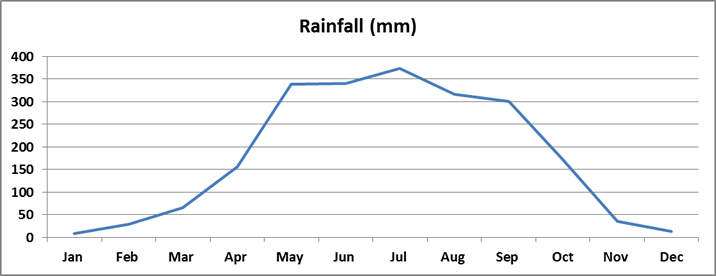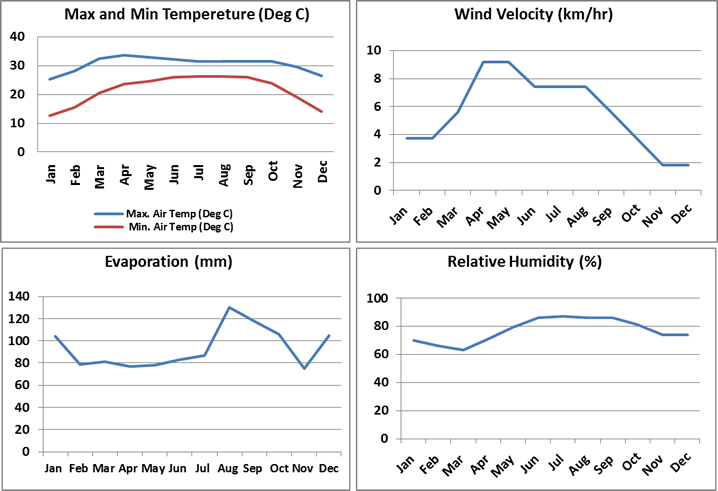Dhaka River Basin (Bangladesh)
Climate
The climatic condition of the basin area is classified as tropical monsoon type, which influences the hydrodynamic features of the Buriganga River. It has four seasons as Pre-monsoon (March to May), Monsoon (June to September), Post-monsoon (October to November), and dry (December to February) season. The long-term mean annual rainfall is over 2,000 mm, and about 80–90% of this occurs during monsoon (May–October). The temporal variations in climatic features such as rainfall intensity, duration, air temperature, relative humidity, evaporation and wind velocity affect the magnitude of discharge along hydrological pathways, which ultimately affect the quality of the river water. A monthly average temperature ranges from 25 to 31 °C, average humidity is 80 to 90 % and evaporation ranges from 80 to 130 mm. The long term monthly average climatic data of the Basin area is presented in Table. Generally the river experiences low tidal (back water) influence in downstream reaches during the wet (monsoon) season, whereas during the dry periods semi-tidal influence occur. The tidal effect during the dry season takes place when the upstream flow becomes very low or non-existent. The average flow of the river during May to October as700 m3/sec and during November to April as 140 m3/sec and the flow rate in Buriganga on the order of 400 to 850 m3/sec during the months from June to October.
Table: Climatic condition of the basin area (Bangladesh Meteorological Department)
| Month | Average rainfall (mm) | No. of rainy days | Max. air temperature (°C) | Min. air temperature (°C) | Relative humidity (%) | Evaporation (mm) | Wind velocity (km/hr) | Seasons |
| Jan | 7.7 | 2 | 25.4 | 12.7 | 70 | 104 | 3.7 | Dry season |
| Feb | 28.9 | 3 | 28.1 | 15.5 | 66 | 79 | 3.7 | |
| Mar | 65.8 | 5 | 32.5 | 20.4 | 63 | 81 | 5.6 | |
| Apr | 156.3 | 10 | 33.7 | 23.6 | 71 | 77 | 9.2 | Wet season |
| May | 339.4 | 14 | 32.9 | 24.5 | 79 | 78 | 9.2 | |
| Jun | 340.4 | 14 | 32.1 | 26.1 | 86 | 83 | 7.4 | |
| Jul | 373.1 | 17 | 31.4 | 26.2 | 87 | 87 | 7.4 | |
| Aug | 316.5 | 16 | 31.6 | 26.3 | 86 | 130 | 7.4 | |
| Sep | 300.4 | 13 | 31.6 | 25.9 | 86 | 118 | 5.6 | |
| Oct | 172.3 | 7 | 31.6 | 23.8 | 81 | 106 | 3.7 | |
| Nov | 34.4 | 2 | 29.6 | 19.2 | 74 | 75 | 1.8 | Dry season |
| Dec | 12.8 | 1 | 26.4 | 14.1 | 74 | 105 | 1.8 |


References and further reading:
Kabir, A., Parolin, B. (2012) Planning and Development of Dhaka – A story of 400 years, University of new south wales, Kensington, NSW 2052, Australia.
Community report, Zila: Dhaka, June 2012, Population and housing census 2011, Bangladesh bureau of statistics Statistics and informatics division, Ministry of planning, Government of the people’s republic of Bangladesh.
Community report, Zila: Gazipur, June 2012, Population and housing census 2011, Bangladesh bureau of statistics Statistics and informatics division, Ministry of planning, Government of the people’s republic of Bangladesh.
Community report, Zila: Narayanganj, June 2012, Population and housing census 2011, Bangladesh bureau of statistics Statistics and informatics division, Ministry of planning, Government of the people’s republic of Bangladesh.
DWASA (2012) Management information system (MIS) report, http://www.dwasa.org.bd/
Hoque, M. A. (2004) Hydrostratigraphy and aquifer piezometry of Dhaka City, Postgraduate Thesis, Institute of Water and Flood Management, BUET, Dhaka, Bangladesh, 37 pp.
Hossain, F. et. al. (2013) Water Resources Vulnerability in the Context of Rapid Urbanization of Dhaka City (a South Asian Megacity), Elsevier Inc., USA.
Majumder, J. R. (2011) A snapshot of socio-economic development of Bangladesh Looking from multiple perspectives.
Rahman, M. A. et al. (2013) Hydrogeological analysis of the upper Dupi Tila Aquifer, towards the implementation of a managed aquifer-recharge project in Dhaka City, Bangladesh, Hydrogeology Journal 21: 1071–1089, Springer-Verlag Berlin Heidelberg, Germany.
Rahman, S., Hossain, F. (2008) Spatial assessment of water quality in peripheral rivers of Dhaka City for optimal re-location of water intake point. Water Resour Manag, 22: 377–391.
Statistical Year Book of Bangladesh (2010) Bangladesh bureau of statistics Statistics and informatics division, Ministry of planning, Government of the people’s republic of Bangladesh.

